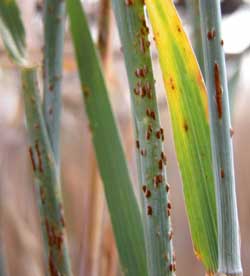South Perth, Western Australia
April 15, 2004
The Department of
Agriculture has identified likely hotspots for rust
infection in cereal volunteer paddocks in southern and eastern
areas of the wheatbelt.
Cereal pathologist Robert Loughman said areas
identified had a greater than normal risk of rust outbreaks from
cereal volunteers that harboured rust diseases over summer and
autumn.
Dr Loughman said cereal volunteers had provided
opportunities for stem rust of wheat, leaf rusts of wheat and
barley and stripe rust of wheat to carryover.
"This is likely to be a problem along the south
coast from Plantagenet to Esperance and through the eastern and
south eastern fringe of the wheatbelt," Dr Loughman said.
"The strongest indication of 2004 rust risk has
been the high number of cereal volunteer paddocks, including
barley, carrying wheat stem rust along the south coast.
"Stem rust is surprisingly widespread along the
south coast right now. It was a problem in crops of Camm and
Yitpi in these areas last year, and susceptible varieties remain
at risk this year."
|
 |
|
Self-sown barley, growing at summer temperatures, is
harbouring wheat stem rust at numerous locations along the
south coast this year. |
Last year, stripe rust survived in several areas
where the green bridge was strongest. Dr Loughman said the
south coast had comparable levels of green bridge this year.
"The Department has received numerous samples of
wheat stem rust and some wheat leaf rust and barley leaf rust
off volunteer wheat and barley. Stripe rust has not been
reported off autumn volunteers, though it could occur in crops
later in the season", Dr Loughman said.
|
Rust risk is significantly greater in districts
where green bridge paddocks persist into autumn because of the
potential to overlap with sown crops. Final impacts from rust
also depend on seasonal climatic conditions including winter and
spring rainfall that drive both crop production and disease
development.
Dr Loughman said growers in the south and east of
the wheatbelt could make final preparations for this year's
cropping program by destroying volunteers, fine tuning variety
options and planning fungicide use.
"Proactive rust management minimised losses from
rusts in 2003, and can be used to minimise losses from rust
diseases in moderate to high risk areas this year," he said.
"Growers who destroyed volunteer cereals in
autumn benefited with improved rust control. They also achieved
stored soil moisture, better weed control and more timely crop
establishment."
Dr Loughman said variety responses to rust could
vary with changes in rust strains.
"Growers should regularly review information on
variety resistance ratings, which would also help them plan
fungicide use." |
 |
|
Estimated risk of rust infections, 2004. |
He said growers were also gaining experience in a
range of fungicide management options.
"Last year's experience with stem rust indicates
that vigilance in crop inspections in spring will be required to
stay on top of rust diseases."
Growers seeking further information on rust
management and advice on control of volunteer cereals can
contact their local office of the Department of Agriculture. |